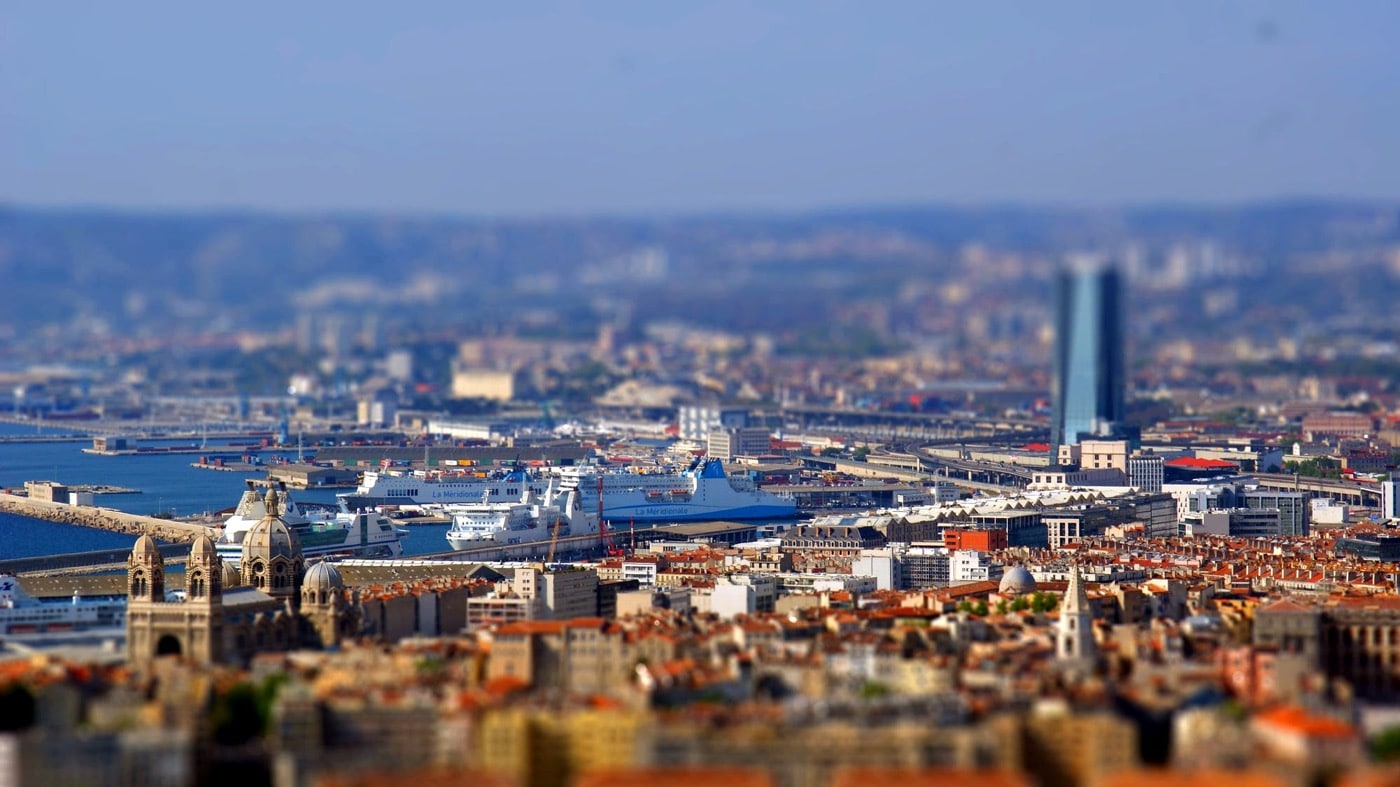Marseille? Who would want to visit this city? Crime, drugs, violence, the Mafia – the city’s reputation has been shrouded by for years. The 1970’s movie, The French Connection, focusing on the city’s thriving drug trade, didn’t help. But, much of the drug trade has moved on to Eastern Europe. And, fortunately policing and public security have improved.
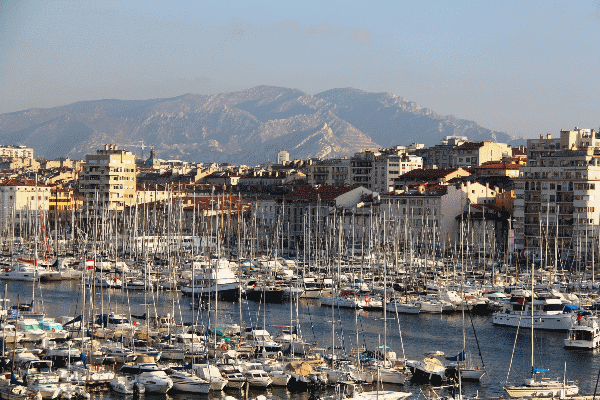
My husband and I live in the Luberon hills, about 1 ½ hours north of Marseille. I’ve been to France’s second largest city numerous times and never encountered any problems. We’ve always enjoyed visiting this bustling, vibrant coastal city. And now – more than ever. The New York Times has rated Marseille second in its list of “46 places to visit in 2013.” Billions of Euros have been spent on innovative new construction, as well as renovating and repainting many of the old structures to ready Marseille for its honor as European Capital of Culture this year, when there is a wealth of activities on the agenda.
Soak in the city’s captivating seaside ambience at the Vieux Port, the old port which is the heart of this city that was founded by the Greeks six centuries before Christ. Every morning fishermen unload their catch at the tip of the port, the Quai des Belges, for the fish market where locals survey the specimens and tourists take photos. “Soles vivantes,” fish still flapping in a shallow pool of water, were a hot item recently, no doubt because it was the sole season as we later learned. The 17th century Hotel de Ville, the majestic, centuries-old home of the city government, is on the right side of the quay facing the water.
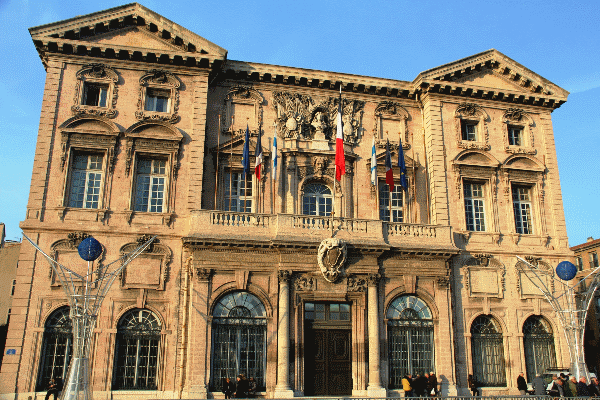
New at the Vieux Port is Norman Foster’s Ombrière, a giant mirror hanging above the repaved waterfront. Slender columns hold a thin sheet of polished steel aloft. Reflected are all those passing underneath, from gnarled fishermen to strolling pedestrians
Nearby is Pavilion M, a temporary multi-level structure of wood and glass erected for Marseille 2013 in the Place Bargemon. We enjoyed its exhibit on the city and its people. On an upper floor you can visit the tourist office for information on the city and special events this year. Tickets for events are also on sale here.
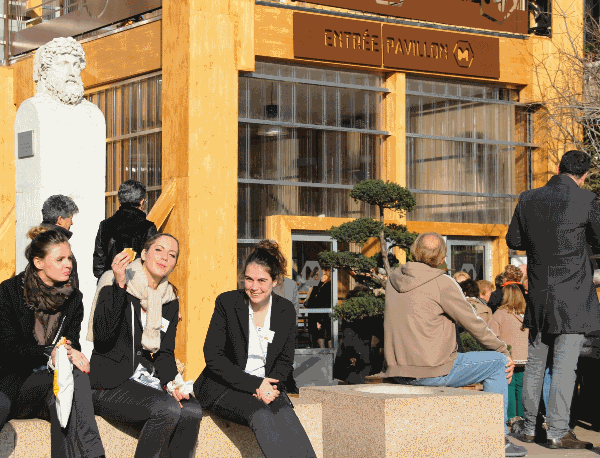
Wandering along the narrow, cobbled alleys of Le Panier is always fascinating. Steep steps from the Vieux Port climb the hills of this district, the oldest part of the city reminiscent of ancient Mediterranean cities like Naples and Lisbon. The Place des Moulins was once home to 15 windmills where flour was milled. The name panier (basket) is thought to come from the baskets used to carry bread. Long neglected and run down, Le Panier is on the move with new boutiques and eateries, especially on Rue du Petit-Puits where I discovered delightful, whimsical ceramics at Serge Mautarlier, number 7.
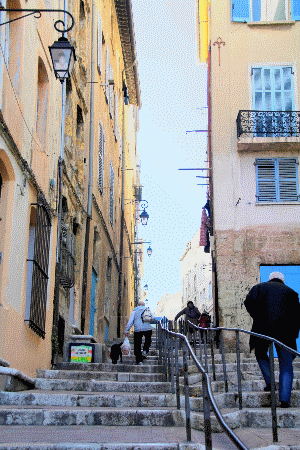
Le Panier’s pièce de résistance is the Vielle Charité, a striking architectural masterpiece that was a home for the city’s poor in the 17th century when Louis XIV decided poor folks on the streets were bad news. It housed up to 1,000 needy residents. The noted architect Le Corbusier recognized its beauty in the 1950s which led to renovation. The complex of columned arcades includes a Baroque domed chapel. Walk along the upper gallery with your camera ready, as I did, for some interesting shots of the courtyard below.
Photo by Leah LarkinAfter all that trekking up and down and around Le Panier, treat yourself to a relaxing boat ride to Chateau d’If. Boats from the Vieux Port cross the waters to this legendary castle, France’s Alcatraz. King Francois I had it built in the 16th century as a fort outside the harbor. It never saw battle, but became a prison. Its most illustrious inmate was Edmond Dantès whom Alexandre Dumas immortalized in The Count of Monte Cristo.
Shopping? I’m a market junkie, and Marseille is a gold mine with its numerous morning markets offering everything from clothing to spices, fruits and vegetables to hardware. The fish market at the Vieux Port is perhaps the most colorful, but you are probably not going to buy a smelly fish. Check out the merchandise at the other markets which reflects the diversity of the city’s population including 200,000 Italians, 150,000 Corsicans, and 400,000 Muslims (mostly from Algeria). Arab specialties are found at the Marché les Noailles on side streets to the right at the end of Canebière, the city’s main thoroughfare, just a few hundred meters from the Vieux Port, every morning except Sunday. Nearby is the Marché des Capucins for fruit and vegetables, also daily except Sunday. Everything imaginable is for sale at the huge Marché du Prado along this main artery of the city, Tuesday through Saturday.
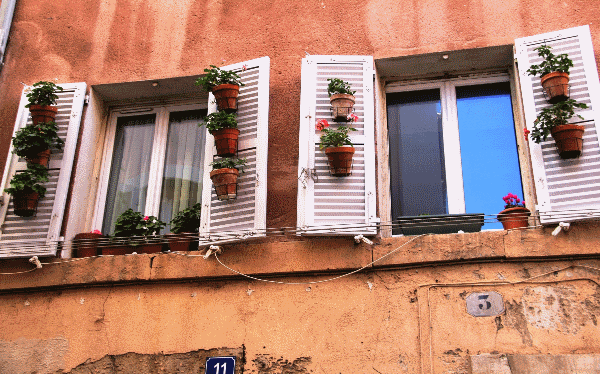
For classier purchases, head to rue Saint-Ferréol, rue de Rome and rue Paradis. Rue Sainte is the place to seek out local fashion labels.
If Marseille has a city symbol, it’s Notre Dame de la Garde, a celebrated church towering over the sprawling city. A golden statue of the Bonne Mère tops this Romanesque-Byzantine basilica at the highest point of the city, 500 feet above the harbor, majestically watching over Marseille’s 860,000 inhabitants.
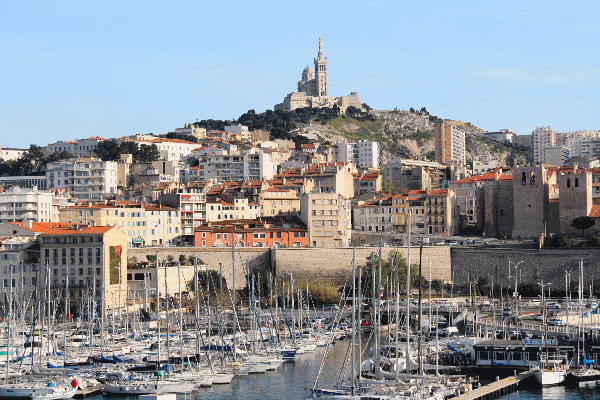
The Marseille street of fame is La Canebière, a grand boulevard which leads from the Vieux Port. A bit shabby, the Champs Élysée it is not, although it was modeled after the Parisian avenue. Some of the buildings are worth admiring, such as the one with caryatides housing the store C&A at number 53.
Food is foremost for me when visiting Marseille. We especially like to savor treats from the sea for which this port city is famous. Marseille is the capital of bouillabaisse, the legendary fisherman’s soup. It’s said to taste better there than anywhere else because of the variety and freshness of ingredients – several kinds of fish. It’s a hearty meal beginning with the fish broth served with aioli, garlic mayonnaise, and rouille, aioli with cayenne pepper. Smear the mayos on toast rounds which you submerge in the soup. Then comes a huge platter of the fish and potatoes. It’s a pricey dish, between 53 and 60 Euros per person at these restaurants all known for authentic bouillabaisse: Le Rhul, chez Michel, Le Miramar and chez Fonfon. A less expensive but authentic version can be ordered ahead at Chez Madie Les Galinettes at the Vieux Port. Other restaurants along the Vieux Port also offer bouillabaisse for less, but it may not be the genuine version.
Years ago we treated ourselves to bouillabaisse at chez Fonfon. The setting in a tiny inlet overlooking the sea was as memorable as the cuisine.
On a recent visit we were charmed with La Bôite à Sardine, a boisterous, small eatery, all decked out with souvenirs of the sea: shells and stuffed fish in nets dangling from the ceiling, a bench with bold orange life vests as cushions around a big corner table, a wall plastered with small sardine cans.
Proprietor Fabian sat us at a table with two friendly women, Jeanne Feutren, 68, and her mother, Claire Gilormini, 93, who live nearby. “We come here because the fish is fresh. It’s delivered every morning. That’s rare. We know,” said Feutren, who, like her mother, was born in Marseille, is a retired English teacher, and, like most natives, a diehard fan of this fascinating city, the oldest in France.
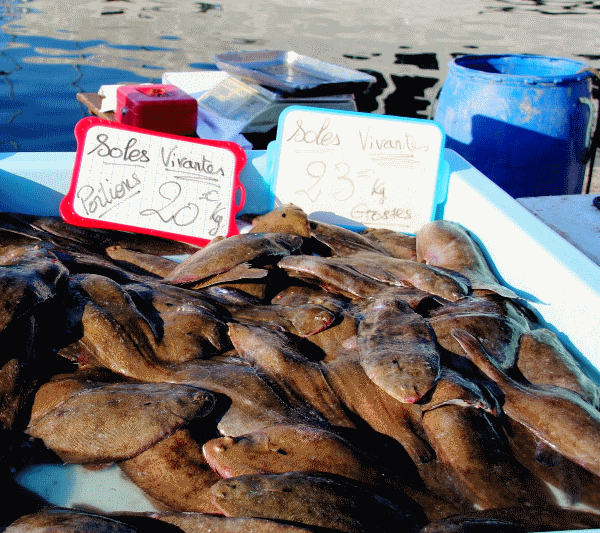
They, and many others, began their meal with platters of oysters. I asked for Fabian’s recommendations, and he suggested we split an order of calamari, then move on to sole for the main course. “It’s the season for sole,” he explained. “They are full of eggs. The taste is the best.” The squid were in a tasty sauce with a side dish of panisse, a local specialty made with chickpea flour. The sole, lightly fried, was exquisite. Fabian made sure we did not miss the cheeks, the minute and delicate portion of flesh under the fish’s eyes.
“I love Marseille. It’s so cosmopolitan,” said Feutren. “You can meet the whole world here. We have the sea, the sand, hills, the calanques (dramatic coastline cliffs). People are so exuberant.” Her mother interjected. “It’s a wonderful town. We have sun year round. It’s January, but look at the weather.” (It was glorious. Marseille has 300 days of sunshine, the highest number of sunny days in France.)
Marseille has much to enjoy, and it’s no longer the den of iniquity as it once was. But, it has its problems – high rate of youth unemployment, corruption… And, as in any big city, caution is advised. Guard your purse. Don’t wear flashy, expensive jewelry. But, do visit and marvel at the new Marseille.
More at www.marseille-tourisme.com
The country code for France is 33.
Where to stay:
Hôtel Escale Oceania Marseille Vieux Port – The location does not get any better than this, just adjacent to the Vieux Port. The small (45 rooms) newly renovated hotel does not offer luxury, but it does have all you need, including free Internet access. Ask for a superior room with a balcony for superb views of the Vieux Port and Notre Dame de la Garde. 5 La Canebière, 04 91 90 61 61 www.oceaniahotels.com/hotel-escale-oceania-marseille
InterContinental Marseille – This five-star hotel just opened in a renovated historic monument behind the Hotel de Ville and no more than a block from the Vieux Port at the edge of Le Panier. It has all the amenities of a luxury establishment: gourmet restaurant, covered pool, spa, plus a lovely terrace for relaxing and enjoying a view of the Vieux Port. 1 Place Daviel, 04 13 42 42 42. www.intercontinental.com/marseille
Casa Honoré – For those seeking something small and intimate, this casa (mini hotel with just four rooms) is the address. The rooms (large and luxurious) are around an inner courtyard with a pool. The hideaway is in the heart of the city in the St. Victor neighborhood close to the Vieux Port. 123 rue Sainte, 04 96 11 01 62 www.casahonore.com
Where to eat:
La Bôite à Sardine – Fish restaurant as described in article, 7 Boulevard de la libération, 04 91 50 95 95, www.laboiteasardine.com
Le Café des Epices – Gastronomic brasserie near the Vieux Port, a tiny but bustling place with innovative cuisine. There is a terrace in front of the restaurant for outdoor dining. Many of the customers are regulars who greet the talented chef with the obligatory air kiss on each cheek. 4 Rue du Lacydon, 04 91 91 22 69.
Pizzeria Jeannot – Much more than a pizzeria, this large restaurant offers all manner of seafood and grilled meats, in addition to a variety of pizzas. The location, tucked in a tiny fishing port just outside the heart of the city, is a delight. 129 Vallon des Auffes, 04 91 52 11 28. www.pizzeriachezjeannot.net
Chez Fonfon – If it’s authentic bouillabaisse you seek, try this well-known restaurant located almost next door to Pizzeria Jeannot, but with a classy ambience on the second floor of a building with lovely views of the sea and the mini harbor full of boats. 140 Rue du Vallon des Auffes, 04 91 52 14 38, www.chez-fonfon.com
What to See & Do:
Calanques/Beaches – Sightseeing boats from the Vieux Port opposite the Hotel de Ville offer coastal tours to admire the stunning cliffs and deep fiord-like inlets between Marseille and Cassis. A two hour trip costs 22 Euros. Boats run daily from April through October. Details at www.visite-des-calanques.com
[caption id="attachment_18775" align="aligncenter" width="600"]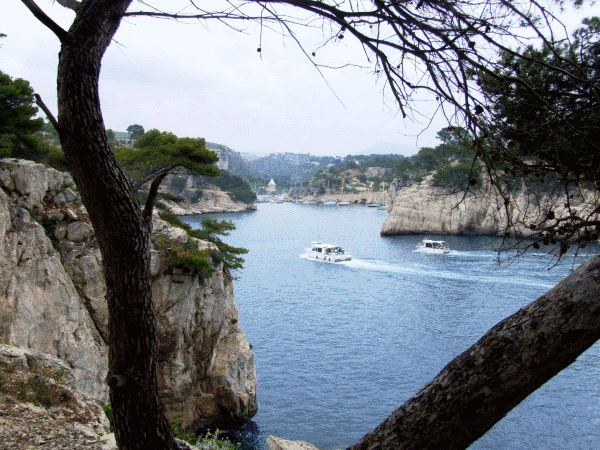 Photo by Leah Larkin[/caption]
Photo by Leah Larkin[/caption]
Marseille has 16 beaches along its 57 kilometers of coastline. The Plage des Catalans offers golden sand, while soft gravel covers the Plage du Prado. Both are crowded in summer.
New Attractions: Villa Méditerranée and Museum of European and Mediterranean Civilizations (MUCEM). Continue down the waterfront from the Vieux Port to an abandoned pier (J4) that is now all spiffed up and the site of avant-garde architecture. The Villa Méditerranée looks much like a supersized diving board with a vast exhibition hall jutting towards the sea and suspended above a pool of water. It will host exhibitions, but it is primarily a place to provide contact for all Mediterranean countries with the focus on cultural and artistic exchanges. There is no charge to enter and wander around, although there is a charge for exhibitions.
President Francois Hollande will inaugurate MUCEM on June 4. Doors open to the public on June 7. This striking structure, a squat glass building shielded from the harsh Mediterranean sun by a dark concrete filigree veil, echoes the architecture of North Africa. Exhibits from national museums will illustrate the theme of Mediterranean civilization.
The J4 area and the adjacent old Fort St. Jean are linked by a 130-meter walkway overlooking a dock. You can stroll in the public Mediterranean garden suspended on the heights of the Fort and lap up the stunning panoramic views over the sea and city.
New Major Cathedral
[caption id="attachment_18784" align="aligncenter" width="600"]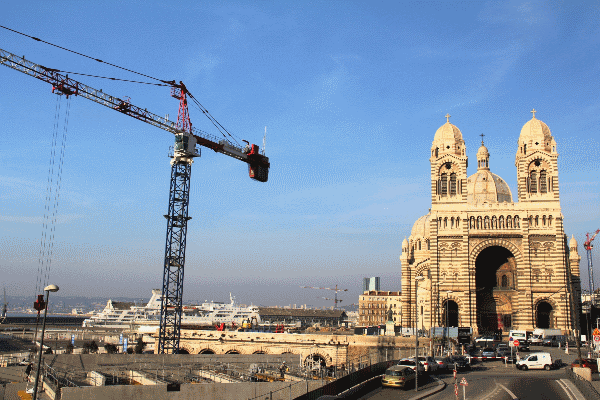 Photo by Leah Larkin[/caption]
Photo by Leah Larkin[/caption]
After visiting the above, continue to the city’s cathedral – you’ll see it ahead just adjacent to the docks. There is much construction in the area now, but the city’s “new” cathedral, consecrated in 1896, merits a visit. Statues of Christ and the apostles decorate the façade, while more beautiful statues are found inside.

